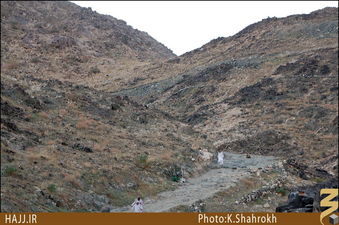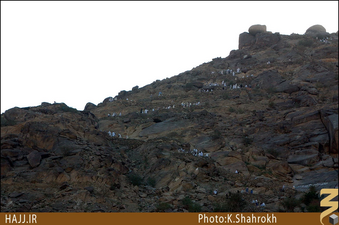Mount Thawr (Mecca)
 | |
The Mount Thawr is a notable mountain located to the south of Mecca. It is renowned for housing the Cave of Thawr, the place where the Prophet Muhammad (S) and his companion Abu Bakr sought refuge during their migration (Hijra) to Medina. This event is a significant moment in Islamic history, symbolizing the Prophet's perseverance and trust in Allah during a time of great adversity.
Mount Thawr is approximately three kilometers away from the Masjid al-Haram, the Grand Mosque of Mecca. It is situated opposite Mount Nur, which is famous for the Cave of Hira where the Prophet Muhammad (S) received his first revelation from Allah through the angel Gabriel. The geographical and historical significance of Mount Thawr adds to the rich tapestry of sacred sites in the region, each marking critical events in the life of the Prophet Muhammad (S) and the early history of Islam.
Location and Features of Mount Thawr
Mount Thawr, with an elevation of 759 meters above sea level, is situated to the south of Mecca along the route to Yemen. It is located approximately three kilometers from the Masjid al-Haram, the Grand Mosque of Mecca, and directly faces Mount Nur, which is notable for the Cave of Hira where the Prophet Muhammad (S) received his first revelation.[1] This mountain is particularly significant in Islamic history due to the presence of the Cave of Thawr on its slopes. It was in this cave that the Prophet Muhammad (S) and his companion Abu Bakr sought refuge during their migration (Hijra) to Medina, an event marking a pivotal moment in the early days of Islam.
Mount Thawr is composed of rocks displaying a variety of colors, including golden, silver, and charcoal hues. This distinctive coloration contributes to the mountain's unique geological appearance and adds to its visual and symbolic significance in the region.
The physical and historical attributes of Mount Thawr make it an important landmark, both geographically and spiritually. Its proximity to other sacred sites, such as the Masjid al-Haram and Mount Nur, further underscores its relevance in the Islamic tradition and the rich historical landscape of Mecca.[2]
The current mountain location
With the recent expansion of the city, Thawr Mountain is now positioned within a network of prominent streets, such as Thawr Street, Taif Road, and Kodi Road.[3] This development has integrated the mountain into the urban fabric, offering a variety of routes for both ascending and descending the peak. The increased accessibility provided by these routes has improved connectivity for residents and visitors, facilitating easier travel to and from the mountain. This integration reflects the city’s growth and its efforts to enhance the convenience and experience of accessing natural landmarks amidst urban settings.[4]
Reason for Naming
The name of the mountain is deeply rooted in historical context. According to resources, Thawr bin Abd Manat, a distinguished figure in local lore, was born at the base of this mountain. In reverence to this significant individual, the area was originally known as Thawr Atahl. Over time, the name was abbreviated to Thawr.[5] The mountain is sometimes called Abu Thawr.[6] Several factors likely contributed to the mountain's naming. One theory suggests that the mountain's southern landscape bears a resemblance to a cow, referred to as Thawr in regional tradition.[7] Another possibility is the presence of the Bani Thawr tribe, who established settlements near the mountain and its surrounding areas.[8] These elements, intertwined with the cultural and religious heritage of the region, have collectively shaped the mountain's nomenclature, reflecting its historical significance and symbolic importance.
Cave of Thawr
Template:Main article Thawr's Cave, located on this prominent mountain, is of considerable significance within Islamic tradition. The mountain is distinguished by its unique geological features and is held in high regard by Muslims due to its historical association with the Prophet Muhammad (S). During the pivotal event of the Hijra, when the Prophet and his companion Abu Bakr sought to escape the intense persecution by the polytheists in Mecca, they found refuge in a cave on this mountain.[9] The site in question comprises two neighboring caves, both revered as potential sanctuaries for the Prophet (S) during the migration to Yathrib (modern-day Medina). According to historical sources, including the accounts of Abu Bakr and Amer bin Fahira, who was the guide for the Prophet during this period, it is believed that the larger of these two caves served as the primary hiding place. This significant event is commemorated in Islamic tradition and is referenced in Verse 40 of Surah At-Tawbah, which highlights the divine support provided to the Prophet and his companion during this period of adversity[10] The academic and historical importance of Thawr's Cave extends beyond its physical characteristics. It represents a symbol of divine protection and guidance during a critical juncture in Islamic history. The cave's association with the Prophet's flight underscores its enduring significance as a site of spiritual and historical reflection, illustrating the intersection of religious faith and historical events in the Islamic narrative.
Traditions Concerning Mount Thawr
Mount Thawr is imbued with a rich tapestry of traditions and narratives that underscore its significance in various historical and religious contexts. One notable tradition holds that Mount Thawr is the site where Abel, the son of Adam, was slain.[11] This account highlights the mountain's association with early biblical events and imbues it with a deep historical resonance. Additionally, some traditions link Mount Thawr to the broader landscape of religious events. According to certain narratives, the mountain is identified as a fragment of a larger geological formation that disintegrated following a divine manifestation associated with the Prophet Moses (AS).[12] This connection positions Mount Thawr as a significant geographical feature influenced by profound spiritual events. Moreover, Mount Thawr is also described as one of the mountains that are connected to the seventh earth, reflecting its esteemed position within the cosmological framework of religious belief.[13] This association underscores the mountain's importance in the broader religious and metaphysical landscape.
Further enriching its significance, another narration attributes a special connection to Mount Thawr through a prophetic tradition. It is said that the mountain called out to the Prophet Muhammad (peace be upon him) and informed him that it had once provided shelter to seventy other prophets.[14] This tradition enhances the mountain’s spiritual and historical importance, symbolizing its role as a sanctuary for revered figures across religious history. These diverse traditions collectively illustrate the multifaceted significance of Mount Thawr, reflecting its central role in religious narratives and its enduring spiritual resonance in various historical contexts.
The Recommendation of Prayer on Mount Thawr
Mount Thawr holds significant spiritual importance in Islamic tradition, being recognized as a site where prayers are especially likely to be answered, particularly during the noon hour (Dhuhur time). This belief underscores the mountain's esteemed status as a place of divine favor and spiritual potency. The tradition emphasizes the auspicious timing for prayers, suggesting a heightened receptivity to supplications made at this sacred location during this specific time of day.[15] In addition to the general recommendation for prayer on Mount Thawr, there is a specific encouragement to perform prayers within the Cave of Thawr. This practice is believed to carry additional spiritual merit and is highly recommended for pilgrims and devout individuals seeking to deepen their religious experience. The act of praying in the Cave of Thawr is seen as a means to attain divine blessings and enhance the efficacy of one’s supplications.[16] Prominent Shiite scholar Sheikh Murtadha Ansari further accentuated the spiritual significance of Mount Thawr by incorporating a special prayer intended for recitation at this holy site into his religious practices. Sheikh Ansari's inclusion of this prayer in his ritualistic guidelines highlights the mountain's revered status and its role in the devotional life of the faithful. His contribution reflects a scholarly endorsement of the spiritual benefits associated with prayer at Mount Thawr, thereby enriching the religious heritage surrounding this sacred location[17]
Gallary
Notes
- ↑ Kurdī, Al-Tārīkh al-qawīm, vol. 2, p. 384.
- ↑ Rafʿat Pāshā,Mirʾāt al-ḥaramayn, vol. 1, p. 63.
- ↑ Qāʾidān, Tārīkh wa āthār-i Islāmī, p. 160.
- ↑ Fākihī, Akhbār Makka fī qadīm al-dahr wa ḥaīthih, vol. 4, p. 203.
- ↑ Ḥamawī, Muʿjam al-buldān, vol. 2, p.86-87; Dīyārbakrī, Tārīkh al-khamīs, vol. 1, p. 324.
- ↑ Ibn Jubayr, Riḥla Ibn Jubayr, p. 83.
- ↑ Bilādī, Muʿjam al-Maʿārif al- Jughrāfīyya, p. 72.
- ↑ Āl-i Basām, Khazānat al-tawārīkh al-najdīyya, vol. 9, p. 218.
- ↑ Fāsī al-Makkī, Shifāʾ al-gharām, vol. 1, p. 464.
- ↑ Ibn Kathīr, Al-Bidāya wa l-nihāya, vol. 6, p. 184; Maqrizī, Imtāʿ al-asmāʾ, vol. 1, p. 58.
- ↑ Ibn Zahīra, Al-Jāmiʿ al-laṭīf, p. 301; Kurdī, Al-Tārīkh al-qawīm, vol. 1, p. 392.
- ↑ Fākihī, Akhbār Makka fī qadīm al-dahr wa ḥaīthih, vol. 4, p. 82; Khārazmī, Ithara al-targhīb, vol. 2, p. 311.
- ↑ Marjānī, Bahjat al-nufūs, vol. 1, p. 336.
- ↑ Ibn Zahīra, Al-Jāmiʿ al-laṭīf, p. 300.
- ↑ Khārazmī, Ithara al-targhīb, vol. 1, p. 236.
- ↑ Fākihī, Akhbār Makka fī qadīm al-dahr wa ḥaīthih, vol. 4, p. 35.
- ↑ Hajj Research Center. Adʿīyya wa ādāb-i Makke-yi mukarrama, p. 204-205.
References
- Āl-i Basām, ʿAbdullāh b. ʿAbd al-Raḥmān. Khazānat al-tawārīkh al-najdīyya. Saudi Arabia:[n.p]1419 AH.
- Bilādī, ʿĀtiq b. Ghayth al-. Muʿjam al-Maʿārif al- Jughrāfīyya. Mecca: Dār al-Makka, 1402 AH.
- Dīyārbakrī, Ḥusayn b. Muḥammad. Tārīkh al-khamīs fī aḥwāl ʾanfas al-nafīs. Beirut: Muʾssisa sha ʿbān, 1283 AH.
- Fākihī, Muḥammad b. Isḥāq. Akhbār Makka fī qadīm al-dahr wa ḥaīthih. Beirut: Dār al- Khiḍr, 1414 AH.
- Fāsī al-Makkī, Muḥammad b. Aḥmad. Shifāʾ al-gharām bi akhbār al-balad al-ḥarām. Translated by Muḥammad Muqaddas. Tehran: Mashʿar, 1386 sh.
- Hajj Research Center. Adʿīyya wa ādāb-i Makke-yi mukarrama. Tehran: Mashʿar, 1386 sh.
- Ḥamawī, Yāqūt b. ʿAbd Allāh al-. Muʿjam al-buldān. Beirut: Dār al-Ṣādir, 1995.
- Ibn Jubayr, Muḥammad b. Aḥmad. Riḥla Ibn Jubayr. Beirut: Dār al-Maktaba al-Hilāl, 1986.
- Ibn Kathīr, Ismāʿīl b. ʿUmar. Al-Bidāya wa l-nihāya. Beirut: Dār al-Fikr, 1407 AH.
- Ibn Zahīra, Muḥammad Jārullāh. Al-Jāmiʿ al-laṭīf fī faḍl-i Makka wa ahluhā wa bināʾ al-Bayt al-Sharīf. Edited by ʿAlī ʿUmar. Cairo: Maktabat al-Thaqāfa al-Dīnīyya, 1423 AH.
- Ibrāhīm Rafʿat Pāshā. Mirʾāt al-ḥaramayn, aw, al-raḥlāt al-ḥijāziyya wa al-ḥaj wa mashāʿirihi al-dīniyya. Beirut: Dār al-Maʿrifa, [n.d].
- Khārazmī, Muḥammad b. Isḥāq al-. Ithara al-targhīb. Mecca: Maktabat Nazār Muṣṭafā al-Bāz, 1418 AH.
- Kurdī, Muḥammad Ṭāhir. Al-Tārīkh al-qawīm li Makka wa bayt Allāh al-karīm. Beirut: : Dār al- Khiḍr, 1420 AH.
- Marjānī, ʿAbdullāh al-. Bahjat al-nufūs wa al-asrār. Beirut: Dār al-Gharb al-Islāmī, 2002.
- Qāʾidān, Aṣghar. Tārīkh wa āthār-i Islāmī-yi Makka wa Madīna. 4th edition. Qom: Nashr-i Mashʿar, 1381 Sh.

